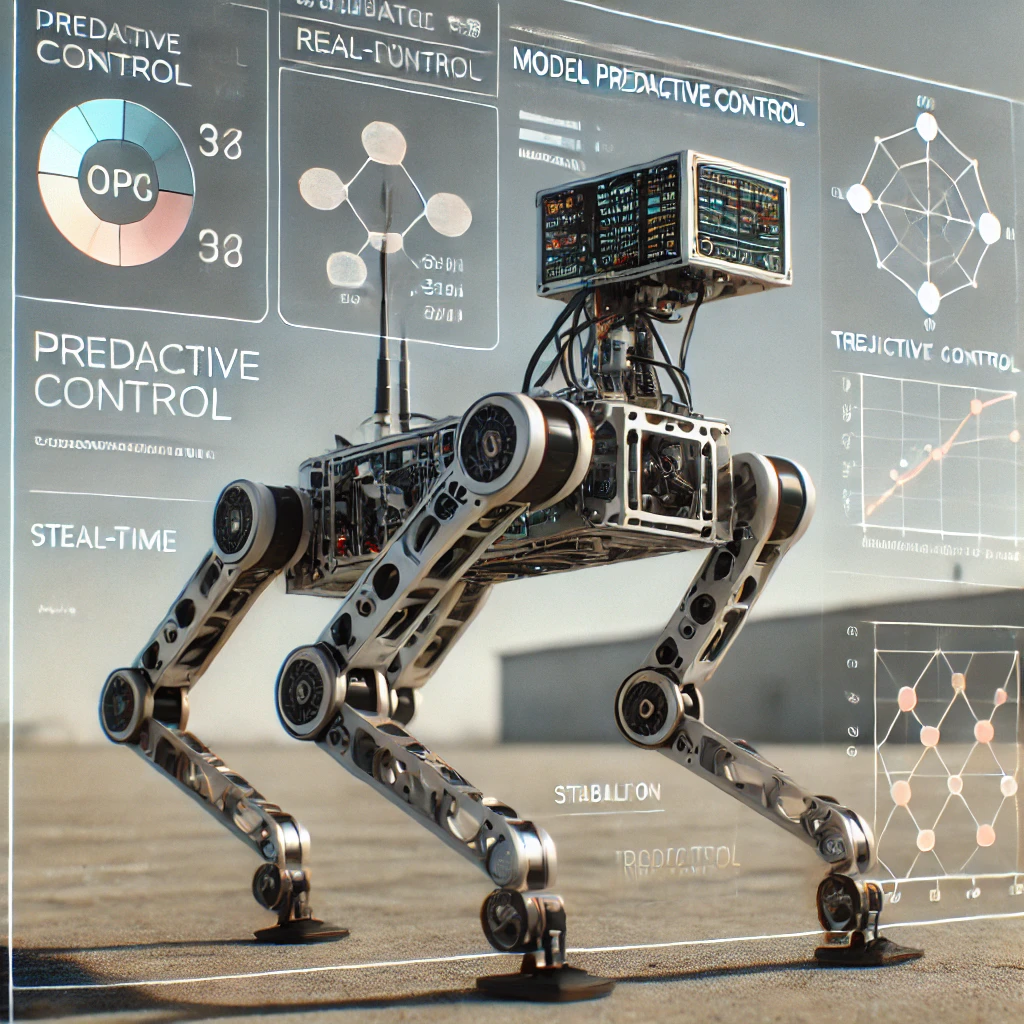Amirhosein Vedadi
Robotics & AI ResearcherLegged robots hold the promise of unmatched mobility and adaptability, allowing them to navigate complex terrains and unstructured environments where traditional wheeled or tracked vehicles are limited. These robots have potential applications spanning from search and rescue missions to infrastructure inspection and even planetary exploration. Realizing this potential, however, depends on advanced control systems capable of orchestrating their intricate movements. Model Predictive Control (MPC) has become a leading control strategy in this area, enabling legged robots to plan and execute dynamic maneuvers while maintaining stability and efficiency. This post provides a comprehensive review of MPC for legged robots, covering its core principles, benefits, challenges, and recent progress.
What is Model Predictive Control?
MPC is an advanced control method that uses a mathematical model of a system to predict its future behavior over a set period. In each control cycle, MPC solves an optimization problem to determine the best control actions. These actions minimize a cost function while adhering to various constraints. These constraints might include the robot's physical limits, like joint or torque constraints, or environmental factors like avoiding obstacles. Only the first optimized control action is applied to the robot. The process is repeated in the next cycle with updated state information; this creates a receding horizon control strategy.
Why MPC for Legged Locomotion?
MPC is well-suited for controlling legged robots for several key reasons:
- Handling Complex Dynamics: Legged robots are complex, with nonlinear dynamics and many degrees of freedom. MPC manages this complexity by incorporating a detailed dynamic model of the robot into the control design.
- Constraint Satisfaction: Legged robots often operate near their physical limits. MPC explicitly handles constraints on joint angles, torques, ground reaction forces, and other variables, ensuring the robot operates safely and feasibly.
- Trajectory Optimization: MPC enables robots to plan optimal trajectories that minimize energy use, maximize speed, or meet other performance goals.
- Disturbance Rejection: MPC can effectively reject external disturbances and adapt to changing conditions by continuously re-planning control actions based on the robot's current state.
- Adaptability: MPC can adapt to different terrains and payloads by adjusting control actions based on sensor feedback and updated environmental information.
Core Components of MPC for Legged Robots
Implementing MPC for legged locomotion involves several key components:
- Dynamic Model: This is a mathematical representation of the robot's dynamics, ranging from simplified models like the Linear Inverted Pendulum Model to more complex articulated rigid body models.
- Cost Function: A mathematical expression that quantifies the desired robot behavior. It balances factors like tracking accuracy, energy efficiency, stability, and smoothness.
- Constraints: A set of inequalities that define the robot's feasible operating region. This includes joint limits, torque limits, friction constraints, and obstacle avoidance constraints.
- Optimization Solver: An algorithm that solves the constrained optimization problem to determine the optimal control actions. Common solvers include quadratic programming (QP) solvers and nonlinear programming (NLP) solvers.
Challenges and Considerations
Despite its advantages, MPC for legged locomotion presents several challenges:
- Computational Complexity: Solving optimization problems in real-time can be computationally demanding, especially with complex robot models and long prediction horizons.
- Model Accuracy: MPC performance relies on the accuracy of the dynamic model. Inaccuracies can lead to suboptimal control actions and reduced performance.
- Tuning and Parameter Selection: MPC involves numerous parameters, like cost function weights and prediction horizon, requiring careful tuning for desired performance.
- Real-time Implementation: Implementing MPC on a physical robot requires careful consideration of computational resources, sensor noise, and communication delays.
Recent Advances and Research Directions
The field of MPC for legged robots is continuously evolving, with ongoing research focused on addressing challenges and expanding possibilities:
- Efficient Optimization Algorithms: Researchers are developing optimization algorithms that can solve MPC problems in real-time, even with complex models.
- Simplified Models: Using simplified models can reduce MPC's computational cost, but it's important that the model captures the robot's essential dynamics.
- Learning-Based MPC: Combining MPC with machine learning can improve the accuracy of dynamic models and enable robots to adapt to changing environments.
- Distributed MPC: Decomposing the MPC problem into smaller, parallel subproblems can reduce computational burden and enable scaling to more complex robots.
- Whole-Body MPC: Using whole-body models in MPC allows for more comprehensive control, enabling more dynamic and versatile locomotion.
- Environment Adaptation: Incorporating environment adaptation techniques into MPC improves a robot's ability to navigate complex terrain and respond to unexpected disturbances.
MPC vs. Reinforcement Learning
MPC and Reinforcement Learning (RL) both offer strategies for controlling legged robots. MPC uses a predefined mathematical model to solve optimization problems in real-time, while RL learns control policies through interaction. RL excels in handling disturbances and maintaining energy efficiency but can struggle generalizing to new terrains. MPC provides enhanced stability and recovery from large disturbances. Current research is exploring combining these approaches, using RL to optimize MPC parameters or using MPC as a supervisory controller for safety while RL handles adaptability.
Conclusion
Model Predictive Control is a powerful technique that has transformed legged robotics. Its ability to handle complex dynamics, satisfy constraints, and optimize trajectories makes it ideal for achieving robust and agile locomotion. While challenges remain, continuous research and development are improving MPC's efficiency, accuracy, and adaptability. This paves the way for the next generation of legged robots, capable of navigating our world with unmatched mobility and intelligence.





